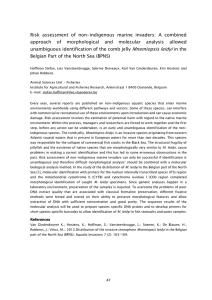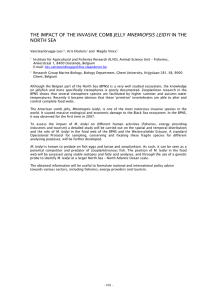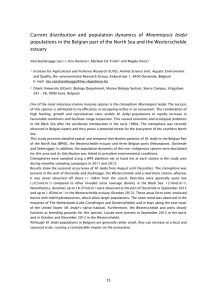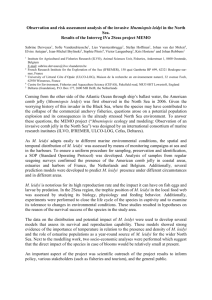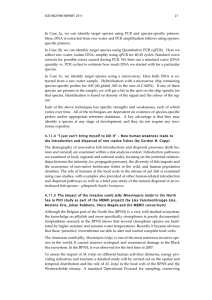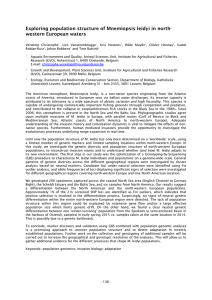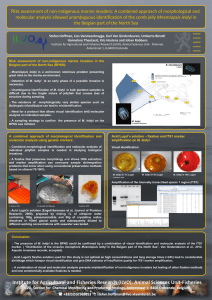Mnemiopsis leidyi
advertisement
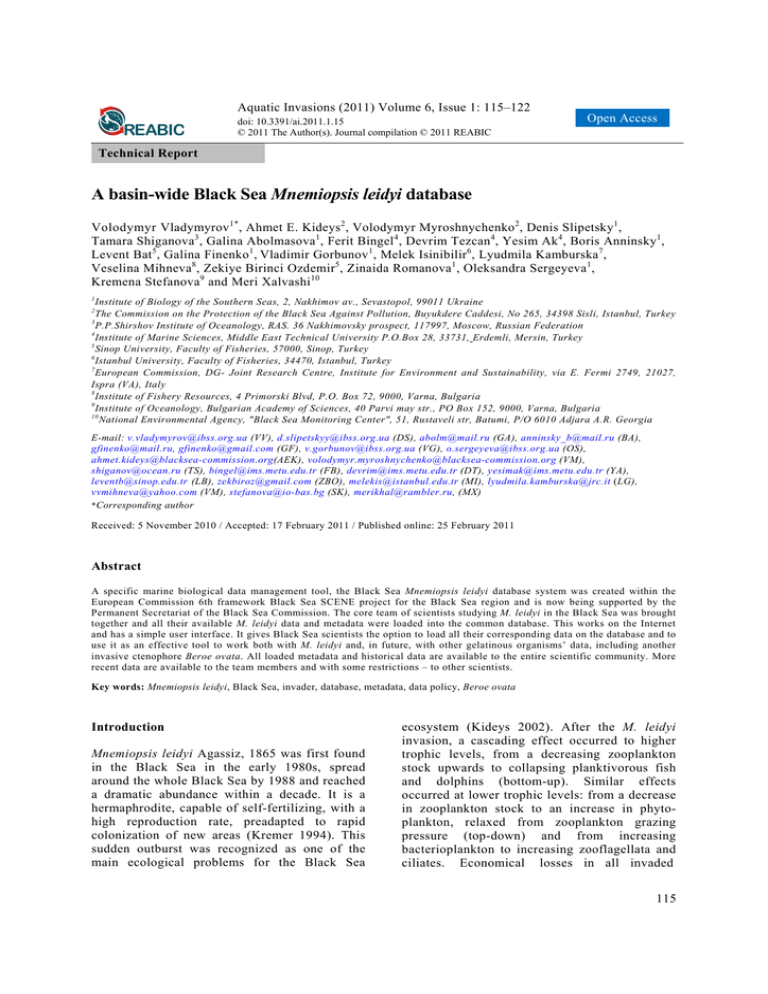
Aquatic Invasions (2011) Volume 6, Issue 1: 115–122 doi: 10.3391/ai.2011.1.15 © 2011 The Author(s). Journal compilation © 2011 REABIC Open Access Technical Report A basin-wide Black Sea Mnemiopsis leidyi database Volodymyr Vladymyrov 1*, Ahmet E. Kideys 2, Volodymyr Myroshnychenko 2, Denis Slipetsky1, Tamara Shiganova3, Galina Abolmasova1, Ferit Bingel4, Devrim Tezcan 4, Yesim Ak 4, Boris Anninsky1, Levent Bat5, Galina Finenko 1, Vladimir Gorbunov 1, Melek Isinibilir6, Lyudmila Kamburska7, Veselina Mihneva8, Zekiye Birinci Ozdemir5, Zinaida Romanova1, Oleksandra Sergeyeva 1, Kremena Stefanova9 and Meri Xalvashi10 1 Institute of Biology of the Southern Seas, 2, Nakhimov av., Sevastopol, 99011 Ukraine The Commission on the Protection of the Black Sea Against Pollution, Buyukdere Caddesi, No 265, 34398 Sisli, Istanbul, Turkey 3 P.P.Shirshov Institute of Oceanology, RAS. 36 Nakhimovsky prospect, 117997, Moscow, Russian Federation 4 Institute of Marine Sciences, Middle East Technical University P.O.Box 28, 33731, Erdemli, Mersin, Turkey 5 Sinop University, Faculty of Fisheries, 57000, Sinop, Turkey 6 Istanbul University, Faculty of Fisheries, 34470, Istanbul, Turkey 7 European Commission, DG- Joint Research Centre, Institute for Environment and Sustainability, via E. Fermi 2749, 21027, Ispra (VA), Italy 8 Institute of Fishery Resources, 4 Primorski Blvd, P.O. Box 72, 9000, Varna, Bulgaria 9 Institute of Oceanology, Bulgarian Academy of Sciences, 40 Parvi may str., PO Box 152, 9000, Varna, Bulgaria 10 National Environmental Agency, "Black Sea Monitoring Center", 51, Rustaveli str, Batumi, P/O 6010 Adjara A.R. Georgia 2 E-mail: v.vladymyrov@ibss.org.ua (VV), d.slipetskyy@ibss.org.ua (DS), abolm@mail.ru (GA), anninsky_b@mail.ru (BA), gfinenko@mail.ru, gfinenko@gmail.com (GF), v.gorbunov@ibss.org.ua (VG), o.sergeyeva@ibss.org.ua (OS), ahmet.kideys@blacksea-commission.org(AEK), volodymyr.myroshnychenko@blacksea-commission.org (VM), shiganov@ocean.ru (TS), bingel@ims.metu.edu.tr (FB), devrim@ims.metu.edu.tr (DT), yesimak@ims.metu.edu.tr (YA), leventb@sinop.edu.tr (LB), zekbiroz@gmail.com (ZBO), melekis@istanbul.edu.tr (MI), lyudmila.kamburska@jrc.it (LG), vvmihneva@yahoo.com (VM), stefanova@io-bas.bg (SK), merikhal@rambler.ru, (MX) *Corresponding author Received: 5 November 2010 / Accepted: 17 February 2011 / Published online: 25 February 2011 Abstract A specific marine biological data management tool, the Black Sea Mnemiopsis leidyi database system was created within the European Commission 6th framework Black Sea SCENE project for the Black Sea region and is now being supported by the Permanent Secretariat of the Black Sea Commission. The core team of scientists studying M. leidyi in the Black Sea was brought together and all their available M. leidyi data and metadata were loaded into the common database. This works on the Internet and has a simple user interface. It gives Black Sea scientists the option to load all their corresponding data on the database and to use it as an effective tool to work both with M. leidyi and, in future, with other gelatinous organisms’ data, including another invasive ctenophore Beroe ovata. All loaded metadata and historical data are available to the entire scientific community. More recent data are available to the team members and with some restrictions – to other scientists. Key words: Mnemiopsis leidyi, Black Sea, invader, database, metadata, data policy, Beroe ovata Introduction Mnemiopsis leidyi Agassiz, 1865 was first found in the Black Sea in the early 1980s, spread around the whole Black Sea by 1988 and reached a dramatic abundance within a decade. It is a hermaphrodite, capable of self-fertilizing, with a high reproduction rate, preadapted to rapid colonization of new areas (Kremer 1994). This sudden outburst was recognized as one of the main ecological problems for the Black Sea ecosystem (Kideys 2002). After the M. leidyi invasion, a cascading effect occurred to higher trophic levels, from a decreasing zooplankton stock upwards to collapsing planktivorous fish and dolphins (bottom-up). Similar effects occurred at lower trophic levels: from a decrease in zooplankton stock to an increase in phytoplankton, relaxed from zooplankton grazing pressure (top-down) and from increasing bacterioplankton to increasing zooflagellata and ciliates. Economical losses in all invaded 115 V. Vadymyrov et al. Figure 1. Map of the available Mnemiopsis leidyi data collected during summers 1998-2004, overall 334 stations (from Kamburska et al. 2006). countries comprised millions US dollars (Shiganova et al. 2004). Ten years later another warm water ctenophore Beroe ovata sensu Mayer 1912 - a predator on M. leidyi - was introduced with ballast waters from the same area (Eastern coastal area of North America) and established. As a result, the M. leidyi population decreased and the ecosystem began to recover its trophic web at all levels (Shiganova et al. 2001; 2004). M. leidyi spread from the Black Sea to the Sea of Marmara, the Aegean Sea with the Black Sea currents and in some areas of Mediterranean with ballast waters (Shiganova et al. 2001). Subsequently M. leidyi has been reported along the French coast of the Mediterranean and the northern Adriatic Sea (Shiganova and Malej 2009); in the southern Levantine Sea (Galil et al. 2009) and in the Western Mediterranean in 2009 (Boero et al. 2009; Fuentes et al. 2009). Interbasin spread to the Caspian Sea occurred in the late 1990s, reportedly due to release of ballast water from the Black and Azov sea basin (Ivanov et al. 2000). In 2006 it was first found in the Baltic and North Seas (Faasse and Bayha 2006; Javidpour et al. 2006, 2009; Boersma et al. 2007). A number of the Black Sea researchers studied M. leidyi and analyzed its distribution, temporal and spatial variability (Shiganova et al., 2001; 2004; Mutlu et al. 1994; Kamburska et al. 2006). An example of the dataset used in a paper (Kamburska et al. 2006) analyzing M. leidyi variability in the Black Sea is presented at Figure 1. This figure shows how small amount of data was available for researches this time. Unfortunately, no basin-wide historical database of the Black Sea M. leidyi was created to analyze, in detail, the spatial distribution and temporal variability of this important species in contrast to the physical and chemical variables 116 for which several comprehensive databases were created for the Black Sea. These include, for example, MEDAR/MEDATLAS project database (Medar/Medatlas II 2002) available on CDROMs, and the NATO SfP Black Sea ODBMS project database available on-line (Black Sea Database 2003) which was supported by the Institute of Marine Sciences of the Middle East Technical University, Turkey (IMS-METU). A similar approach could not be achieved for the biological data. For M. leidyi only a rather small numbers of datasets could be found within the NATO SfP Black Sea ODBMS project database, which do not provide the option to analyze in detail the spatial distribution and temporal variability of M. leidyi that became for decades the main driver of changes in ecosystem functioning. Mnemiopsis leidyi Database creation Due to this reason, a prototype of the Black Sea M. leidyi Database (MLDB) was created in 2008 to load all available metadata and data. The difference between data and metadata is that the latter contain only full information on measurements including date, time, depth, etc. without including the data. MLDB was developed within the EC 6th Framework Programme Black Sea SCENE Project by the Institute of Biology of the Southern Seas, Ukraine (IBSS) and the IMS-METU. This provides Black Sea scientists with a possibility to upload all their corresponding data and to use it as an effective tool to work with M. leidyi data. The first version of the MLDB included all M. leidyi data freely available at that moment. Mostly the data originated from the NATO TUBlack Sea project database (6 data sets from IMS METU and 3 data sets from IO RAS, overall 735 sampling stations for 1989-1995). A test data set from IBSS (1 data set, 5 stations for 2005) was also included. In December 2008, the workshop on the Black Sea M. leidyi Database was organized with the participation of experts and the main regional M. leidyi data holders under the umbrella of the Permanent Secretariat of the Commission on the Protection of the Black Sea Against Pollution (BSC-PS) in Istanbul, Turkey (Mnemiopsis leidyi Database 2008). The meeting took the decision “To create the comprehensive user friendly web based regional Black Sea Mnemiopsis leidyi and A Basin-wide Black Sea Mnemiopsis leidyi database Beroe ovata Database” and defined following main tasks to be done: to analyze the compatibility of the existing Black Sea Mnemiopsis leidyi and Beroe ovata datasets; to collect all existing Mnemiopsis leidyi and Beroe ovata data and metadata, to check their quality, and to upload them into the database (quality check is being recently done at the metadata level using the same procedures that are in use for the Black Sea physical and chemical data QC (http://www. ocean.nodc.org.ua/QC.php); to discuss and agree on the unified methodology of the Mnemiopsis leidyi and Beroe ovata sampling, processing, and data formats. The fully loaded M. leidyi database was planned to be ready by the end of September 2009. Several requirements were defined for the M. leidyi database taking into account all user needs: a database freely accessible over the Internet should be implemented as a web application with a web based user friendly interface; provide simple GIS features; show data and metadata from the database by different search criteria; export selected data or metadata in a file in the agreed comma separated values format (CSV); enable the system administrator to load new datasets into the database and/or edit existing datasets in case the updated/ changed data are provided by the data provider. The MLDB can be formally subdivided in two main parts: the web interface and the database itself. For the web interface implementation the ASP.Net framework was used along with the MS SQL Express/Server 2005 as relational database management system at the backend. To meet the second requirement (GIS features) the Minnesota MapServer was used (MapServer 2010). Example of the MLDB screenshot available online (http://81.8.63.74/MLDB/dataporviders. aspx) that shows the main MLDB user possibilities to select the necessary data and metadata is shown at the Figure 2. Within the database, the data are organized into datasets (e.g. research cruises or time series) which contain station(s) with coordinates and the station(s) contain metadata and data of the individual sample(s). Metadata for the samples includes a description of the sampling method, the dimension of the water layer sampled, the type of the net, its mesh size, etc. Datasets can be grouped according to the data providers who supplied the data. Test version of the MLDB web site was published in October 2008. The MLDB home page (Mnemiopsis leidyi Database 2008) also contains reference information on M. leidyi and links to other relevant information. Metadata are available via two menu topics: “Data Providers” and “Datasets”. On the “Data providers” page, users may see a list of the providers who have submitted at least one dataset. Upon selecting a provider the user can see the list of submitted datasets and a map of all stations of this provider. More details on the datasets can be found on the “Datasets” web page. A complete list of all available datasets is presented at this page along with the detailed description (project, responsible persons, abstract, contact details, etc.) for selected dataset. Selecting a particular dataset the user can view the list of all its stations, which are also plotted on the map. User can select the particular station in the list and highlight its position on the map. The search page enables a user to specify a search criteria (values range, coordinates, units, parameters, data set) and to fetch the desired set of values or get all available values of abundance and/or biomass of M. leidyi. The search results are being presented in a table and the user can save them as a file in CSV format. These data can be used for statistical analyses, mapping, etc. with the help of user selected applications. The management of the database itself is being done by the database administrator via a desktop interface, which is implemented as a stand-alone MS Access application. The administrator has the following rights: - to add and edit data on data providers, datasets, stations, samples and data themselves into the database; - to edit vocabularies like net types, size groups, etc.; - to import data into the database from a CSV file; - to register new users; - to support users in any complicated queries to select the necessary data and metadata. 117 V. Vadymyrov et al. Figure 2. Example of the MLDB screenshot available on-line (http://81.8.63.74/MLDB/dataporviders.aspx) that shows the main MLDB user possibilities to select the necessary data and metadata. Data deletions can only be made by the database administrator in a manual mode. This is done to prevent the database from accidental deletion of data. The database administrator can also: to define the schedule database backup procedures to protect the system from data loss due to technical failures; to add and edit data on data providers, datasets, stations, samples and data themselves into the database; to edit vocabularies like net types, size groups, etc.; to import data into the database from a CSV file; to register new users; to support users in any complicated queries to select the necessary data and metadata. 118 MLDB data usage policy A data policy for the MLDB usage was agreed during the first MLDB workshop containing the following main provisions: all metadata for any year will be freely available for any user through the M. leidyi Database web site; each data contributor will provide M. leidyi data older than 5 years (based on the sampling date) for inclusion into the MLDB. Unless otherwise stated by the data contributor, the data older than 15 years will be freely accessible at the MLDB web site, whereas data from the previous 5 to 15 years will be accessible only to all registered users. However the data usage requires A Basin-wide Black Sea Mnemiopsis leidyi database permission from the corresponding data contributor; data contributors are encouraged to provide their data to MLDB with no access restriction applied. This issue is being discussed and underlined at each annual MLDB meeting. All submitted data will be included in MLDB within two months after the submission. During the Second MLDB workshop held in September 2009 in Istanbul, Turkey, the MLDB data policy was partly updated: it was decided to decrease the restricted period from 15 years to 10 years to make the MLDB easier accessible for users. Further data submissions should be organized on an annual basis: all new metadata and data older than 5 years will be submitted to the MLDB during the first two months of a year and will be included in the database within two months after the submission. Unfortunately, work on the data and metadata collection and the associated quality check was going slowly than it was envisaged, mostly due to the volunteer character of this work. Only the development of the first version of the MLDB and the MLDB meetings were partly funded. Therefore the first version of the regional MLDB was ready only in July 2010. The MLDB data policy was once more changed at the third MLDB workshop held in October 2010. Now all data older than 5 years should be transferred to the MLDB and can be freely used by MLDB users. A proposed data citation system is given on the MLDB web site (topic “Terms of use” of the main menu). Statistics of the data loaded into the MLDB The recently loaded database covers a period from 1989 until 2009 inclusive and by our estimation includes about 75% of all available M. leidyi data ever collected within the Black Sea. Unfortunately, we did not manage yet to find the earliest data, i.e. before 1989, however we still hope that they will be found. The general statistics of the MLDB is shown in the Table 1. Data and metadata were provided by 13 data providers (Appendix 1). Statistics of metadata and data supplied by the data providers are presented in the same table. At the moment 69 data sets have been provided. The datasets are the arbitrary units, they contain up to several hundred stations and are kept in the database to Table 1. General statistics of the MLDB (number of Data sets, Stations, Samples, and Data values at the end of each year (for 2010 – till July 01). . Providers Data sets Stations Samples Data values 2008 2009 2010 3 8 743 745 745 12 51 1721 2940 1919 13 69 2359 3768 2825 Figure 3. Sampling sites of all data and metadata loaded into the database by June 2010. easily connect the data with the data providers. In total, the data collected in the MLDB contain 2359 stations, 3769 samples and 2825 data values. There is a difference between the number of samples and the number of data values because, according to the agreed MLDB data policy, only metadata for the most resent 5 years should be provided. The positions of all stations from where data and metadata were loaded into the database by June 2010 are shown in Figure 3, clearly indicating that the spatial data coverage is very good, especially along the coastal areas. Figure 4 shows the temporal interannual distribution of data. The data of M. leidyi measurements available in MLDB covers the period 1989 – 2009. The maximum data (more than 250 samples) were collected in 1992, 1996, and 2008. The minimum data (less than 125 samples) were collected in 1989, 1990, 1998, and 1999. The full data collection for 2009 has not yet been completed. Unfortunately data for surveys from the beginning of the M. leidyi appearance in the Black Sea are not available (Vinogradov et al. 1989; Vinogradov et al. 1992). 119 V. Vadymyrov et al. 350 Figure 4. Temporal distribution of the Mnemiopsis leidyi data (number of measurements for each year). Number of samples 300 250 200 150 Metadata Data 100 50 0 600 Figure 5. Monthly distribution of the Mnemiopsis leidyi data (summary for all years). Metadata Data Number of samples 500 400 300 200 100 0 The monthly distribution of collected data is shown in Figure 5. The chart is indicative of normal Black Sea research activity with a minimum during the winter season and a maximum during the spring – autumn period. The main reason for this is the heavy storms that are often a feature of the winter season in the Black Sea. Results and recommendations A draft version of the comprehensive Mnemiopsis leidyi database that contains all available data and metadata on M. leidyi for the Black Sea has been created. The collected data 120 are being quality checked, analyzed for the compatibility by the regional experts, and can be used to analyze changes on various spatial and temporal scales starting from the time of its introduction into the Black Sea until recently. The continuing maintenance and extension of the MLDB is a commendable example of how the product created within a scientific project can be sustained after the project’s lifetime with voluntary support of the regional scientific community and cooperation with international organization. It is also planned to share the collected data with SeaDataNet/BlackSea SCENE, EurOBIS/EMODNET international databases. One of the next steps for this work A Basin-wide Black Sea Mnemiopsis leidyi database should include the collection, quality checks, and loading to the database of available datasets on all other Black Sea gelatinous species such as Aurelia aurita (Linnaeus, 1758), Rhizostoma pulmo (Macri, 1778), Pleurobrachia pileus (O. F. Müller, 1776), etc. The collected data should then be scientifically analyzed so that recommendations for the improvements of the measurements network and adaptation of the monitoring plans can be produced. Acknowledgements This work was supported in part by the European Commission 6th Framework Programme Project Black Sea SCENE; by the OCEANUKRAINE, a project Supported by the Flemish Government Department of Foreign Affairs; by the EC 7th Framework Programme Project Upgrade Black Sea SCENE; and by the Permanent Secretariat of the Black Sea Commission. We would like also to acknowledge the big input by Prof. Dr. Erhan Mutlu in terms of the MLDB creation, by providing the substantial contribution of the data and by his active participation in the MLDB workshops. Publication of this paper was supported by the EC 7th Framework Programme through the enviroGRIDS project (Grant Agreement n° 226740) and Russian State Contract № 14.740.11.0422. References Black Sea Database (2003) Black Sea inter-disciplinary multivariable http://sfp1.ims.metu.edu.tr/ODBMSDB/ historical database, (Accessed 05 January 2010) Boero F, Putti M, Trainito E, Prontera E, Piraino S, Shiganova TA (2009) First records of Mnemiopsis leidyi (Ctenophora) from the Ligurian, Thyrrhenian and Ionian Seas (Western Mediterranean) and first record of Phyllorhiza punctata (Cnidaria) from the Western Mediterranean. Aquatic Invasions 4: 675–680, doi:10.3391/ai.2009.4.4.13 Boersma M, Malzahn AM, Greve W, Javidpour J (2007) The first occurrence of the Mnemiopsis leidyi in the North Sea. Helgoland Marine Research 61: 153–155, doi:10.1007/s10152-006-0055-2 Faasse MA, Bayha KM (2006) The ctenophore Mnemiopsis leidyi A. Agassiz 1865 in coastal waters of the Netherlands: an unrecognized invasion? Aquatic Invasions 1: 270–277, doi:10.3391/ai.2006.1.4.9 Fuentes VL, Atienza D, Gili J-M, Purcell JE (2009) First record of Mnemiopsis leidyi A. Agassiz 1865 off the NW Mediterranean coast of Spain. Aquatic Invasions 4: 671–674, doi:10.3391/ai.2009.4.4.12 Galil B, Kress N, Shiganova T (2009) First record of Mnemiopsis leidyi A. Agassiz, 1865 (Ctenophora; Lobata; Mnemiidae) off the Mediterranean coast of Israel. Aquatic Invasions 4: 356– 362, doi:10.3391/ai.2009.4.2.8 Ivanov VP, Kamakin AM, Ushivtsev VB, Shiganova TA, Zhukova OP, Aladin N, Wilson SI, Harbison GR, Dumont HJ (2000) Invasion of the Caspian Sea by the comb jellyfish Mnemiopsis leidyi (Ctenophora). Biological Invasions 2: 255–258, doi:10.1023/A:1010098624728 Javidpour J, Sommer U, Shiganova TA (2006) First record of Mnemiopsis leidyi A. Agassiz 1865 in the Baltic Sea. Aquatic Invasions 1: 299–302, doi:10.3391/ai.2006.1.4.17 Javidpour J, Molinero JC, Lehmann A, Hansen T, Sommer U (2009) Annual assessment of the predation of Mnemiopsis leidyi in a new invaded environment, the Kiel Fjord (Western Baltic Sea): a matter of concern? Journal of Plankton Research 31: 729–738, doi:10.1093/plankt/fbp021 Kamburska L, Schrimpf W, Djavidnia S, Shiganova T, Stefanova K (2006) Addressing the ecological issue of the invasive species: Special focus on the ctenophore Mnemiopsis leidyi (Agassiz, 1865) in the Black Sea. EC JRC Institute for Environment and Sustainability. EUR 22310 EN, 59 pp Kideys A (2002) Fall and Rise of the Black Sea Ecosystem. Science. 30 August 2002: Vol. 297. 5586: 1482–1484, doi:10.1126/science.1073002 Kremer P (1994) Patterns of abundance for Mnemiopsis in U.S. coastal waters: a comparative overview. ICES Journal of Marine Science 51: 347–354, doi:10.1006/jmsc.1994.1036 MapServer (2010) http://mapserver.gis.umn.edu/ (Accessed 05 January 2010) Medar/Medatlas II (2002) Mediterranean Data Archaeology and Rescue. http://www.ifremer.fr/medar/ (Accessed 05 January 2010) Mnemiopsis leidyi Database (2008) http://ps-blacksea-commis sion. ath.cx/MLDB/Default.aspx (Accessed 05 January 2010) Mutlu E, Bingel F, Gucu A, Melnikov V, Niermann U, Ostrovskaya N, Zaika V (1994) Distribution of the new invader Mnemiopsis sp. and the resident Aurelia aurita and Pleurobrachia pileus populations in the Black Sea in the years 1991-1993. ICES Journal of Marine Science 51: 407–421, doi:10.1006/jmsc.1994.1042 Shiganova TA, Malej A (2009) Native and non-native ctenophores in the Gulf of Trieste, Northern Adriatic Sea. Journal of Plankton Research 31: 61–71, doi:10.1093/plankt/fbn102 Shiganova T, Mirzoyan Z, Studenikina E, Volovik S, SiokouFrangou I, Zervoudaki S, Christou E, Skirta A, Dumont H (2001) Population development of the invader ctenophore Mnemiopsis leidyi in the Black Sea and other seas of the Mediterranean basin. Journal of Marine Biology 139: 431– 445, doi:10.1007/s002270100554 Shiganova T, Dumont H, Mikaelyan A, Glazov D, Bulgakova Y, Musaeva E, Sorokin P, Pautova L, Mirzoyan, Studenikina E (2004) Interaction between the Invading Ctenophores Mnemiopsis leidyi (A. Agassiz) and Beroe ovata Mayer 1912, and their Influence on the Pelagic Ecosystem of the Northeastern Black Sea. In: Dumont H, Shiganova T, Niermann U (eds) The Ctenophore Mnemiopsis leidyi in the Black, Caspian and Mediterranean Seas and other aquatic invasions - NATO ASI Series, 2. Environment. Kluwer Acad. Pub., pp 33– 70 Vinogradov ME, Shushkina EA, Musaeva EI, Sorokin PY (1989) Ctenophore Mnemiopsis leidyi (A.Agassiz) (Ctenophora: Lobata) - new settler in the Black Sea. Oceanology 29: 293–298 Vinogradov ME, Sapozhnikov VV, Shushkina EA (1992) The Black Sea ecosystem. Nauka Press, Moscow, 112 pp 121 V. Vadymyrov et al. Appendix 1. List of the MLDB data providers and statistics of all metadata and data provided by them till 1 July 2010. No Provider Name Organization Country 1 Dr. Boris Anninsky Institute of Biology of the Southern Seas NASU UKRAINE 2 Prof. Dr. Erhan Mutlu Akdeniz University, Fisheries Faculty TURKEY 3 Dr. Galina Finenko, Dr. Galina Abolmasova Institute of Biology of the Southern Seas NASU UKRAINE 4 Dr. L.Kamburska, K.Stefanova Institute of Oceanology BAS BULGARIA 5 Dr. Melek Isinibilir Istanbul University, Faculty of Fisheries TURKEY 6 Dr. Tamara Shiganova Shirshov Institute of Oceanology RAS RUSSIAN FEDERATION 7 Dr. Yesim Ak Institute of Marine Sciences METU TURKEY 8 Dr. Zinaida Romanova Institute of Biology of the Southern Seas NASU UKRAINE 9 Mrs. Meri Xalvashi National Environmental Agency "Black Sea Monitoring Center" GEORGIA 10 Mrs. Vesselina Mihneva Institute of Fishery Rresources BULGARIA 11 Prof. Dr. Levent BAT, Mrs. Zekiye Birinci Özdemir Sinop University, Faculty of Fisheries TURKEY 12 Prof Ahmet E. Kideys Institute of Marine Sciences METU TURKEY 13 SIO RAS LFPE Shirshov Institute of Oceanology Laboratory of Functioning of Pelagic Ecosystems RUSSIAN FEDERATION Total 122 Data sets Stations Samples Data 1 32 32 0 11 859 880 747 2 17 890 478 12 265 265 265 1 5 5 5 20 446 523 411 2 26 130 0 5 143 143 143 1 2 5 5 2 49 127 127 2 7 168 44 7 256 346 346 3 252 254 254 69 2359 3768 2825
